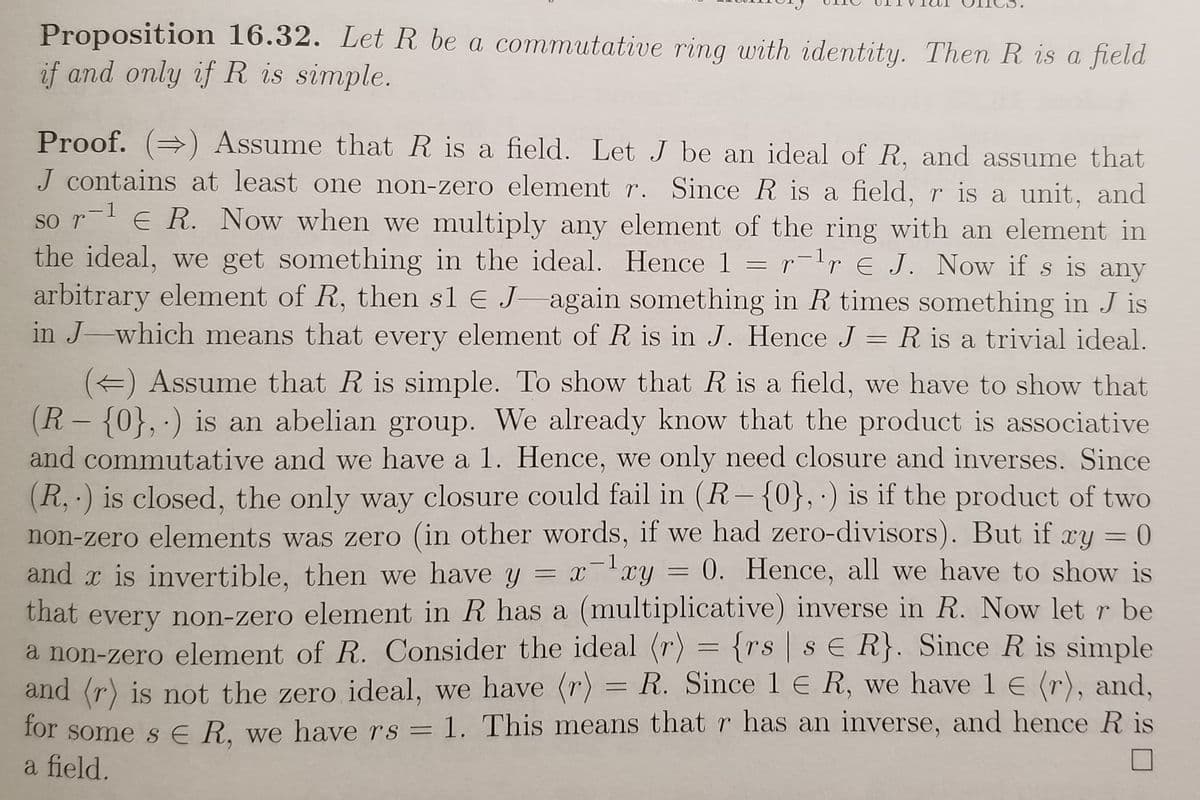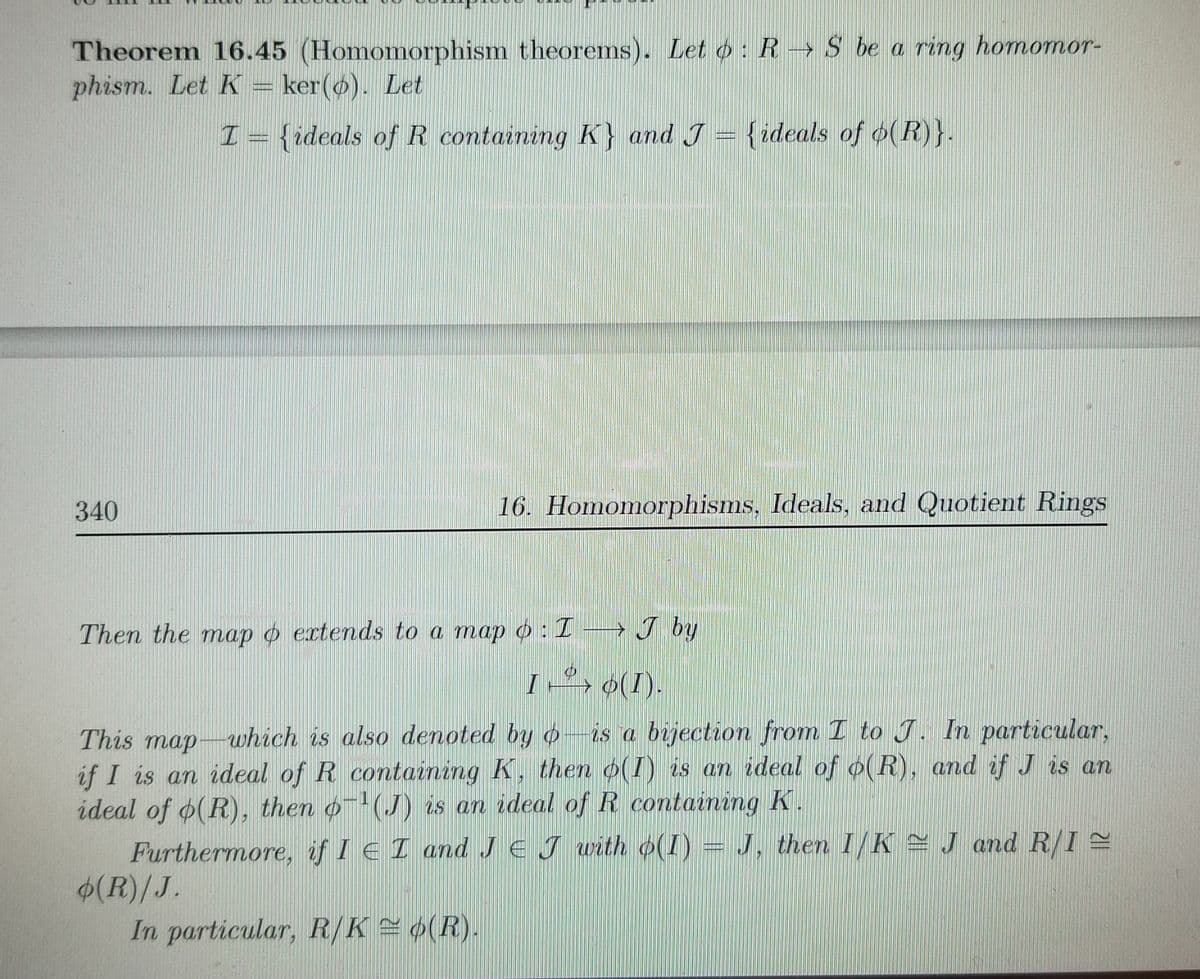Let R be a commutative ring with identity. Using the homomorphism theorem (Theorem 16.45) and Proposition 16.32, show that an ideal M of R is maximal if and only if R/M is a field.
Let R be a commutative ring with identity. Using the homomorphism theorem (Theorem 16.45) and Proposition 16.32, show that an ideal M of R is maximal if and only if R/M is a field.
Elements Of Modern Algebra
8th Edition
ISBN:9781285463230
Author:Gilbert, Linda, Jimmie
Publisher:Gilbert, Linda, Jimmie
Chapter5: Rings, Integral Domains, And Fields
Section5.3: The Field Of Quotients Of An Integral Domain
Problem 10E: Since this section presents a method for constructing a field of quotients for an arbitrary integral...
Related questions
Question
Let R be a commutative ring with identity. Using the homomorphism theorem (Theorem 16.45) and Proposition 16.32, show that an ideal M of R is maximal if and only if R/M is a field.

Transcribed Image Text:Proposition 16.32. Let R be a commutative ring with identity. Then R is a field
if and only if R is simple.
Proof. () Assume that R is a field. Let J be an ideal of R, and assume that
J contains at least one non-zero element r. Since R is a field, r is a unit, and
so r-l E R. Now when we multiply any element of the ring with an element in
the ideal, we get something in the ideal. Hence 1 = r-1r E J. Now if s is any
arbitrary element of R, then sl € J-again something in R times something in J is
in J-which means that every element of R is in J. Hence J = R is a trivial ideal.
() Assume that R is simple. To show that R is a field, we have to show that
(R- {0}, ·) is an abelian group. We already know that the product is associative
and commutative and we have a 1. Hence, we only need closure and inverses. Since
(R,·) is closed, the only way closure could fail in (R-{0}, ·) is if the product of two
non-zero elements was zero (in other words, if we had zero-divisors). But if ry = 0
and x is invertible, then we have y = xxy = 0. Hence, all w
that every non-zero element in R has a (multiplicative) inverse in R. Now let r be
a non-zero element of R. Consider the ideal (r) = {rs sE R}. Since R is simple
and (r) is not the zero ideal, we have (r) = R. Since 1 E R, we have 1 E (r), and,
for some s E R. we have rs = 1. This means that r has an inverse, and hence R is
a field.
-1

Transcribed Image Text:Theorem 16.45 (Homomorphism theorems). Let o: R S be a ring homomor-
phism. Let K = ker(ø). Let
I= {ideals of R containing K} and J = {ideals of o(R)}.
340
16. Homomorphisms, Ideals, and Quotient Rings
Then the map o extends to a map o: I–→ I by
I2, 0(1).
This map-which is also denoted by o-is a bijection from I to J. In particular,
if I is an ideal of R containing K, then o(1) is an ideal of o(R), and if J is an
ideal of o(R), then o(J) is an ideal of R containing K.
Furthermore, if I e I and J EI with o(I) = J, then I/K=J and R/I =
$(R)/J.
In particular, R/K= 6(R).
Expert Solution
This question has been solved!
Explore an expertly crafted, step-by-step solution for a thorough understanding of key concepts.
This is a popular solution!
Trending now
This is a popular solution!
Step by step
Solved in 2 steps

Knowledge Booster
Learn more about
Need a deep-dive on the concept behind this application? Look no further. Learn more about this topic, advanced-math and related others by exploring similar questions and additional content below.Recommended textbooks for you

Elements Of Modern Algebra
Algebra
ISBN:
9781285463230
Author:
Gilbert, Linda, Jimmie
Publisher:
Cengage Learning,

Elements Of Modern Algebra
Algebra
ISBN:
9781285463230
Author:
Gilbert, Linda, Jimmie
Publisher:
Cengage Learning,